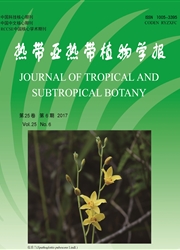

 中文摘要:
中文摘要:
麻黄属(Ephedra)的分子系统学研究结果明显不同于基于雌球果成熟苞片质地的传统分类,指出麻黄属的形态特征和分子特征存在冲突。对麻黄属53种植物的种子表面微形态特征进行了研究,结果表明麻黄属的种子表面纹饰包括3种主要类型,即横向片层型(T型)、乳突型(P型)和扁平型(S型)。麻黄属的种子表面纹饰特征既与宏观形态特征不相关,也与分子系统学的研究结果不相关,表明该属微形态特征、宏观形态特征和分子特征之间的更多冲突。在欧洲和东亚发现的与买麻藤类有关的几个大化石带有T型种子表面纹饰,暗示具有T型纹饰的麻黄类植物在早白垩纪就十分多样。
 英文摘要:
英文摘要:
Recent molecular systematic studies have consistently given results markedly different from the traditional classifications of Ephedra based on such macromorphological characters as the bract nature of ripe female cones,suggesting a serious conflict occurs between molecular and morphological characters.The cuticular micromorphology of the seed outer envelope(SOE) of living Ephedra encompassing 53 extant taxa of Ephedra were investigated.The results indicates that sculpture of SOE of Ephedra bears useful characters and includes 3 major types,viz.the Transverse lamellar type(T-type),the Papillate type(P-type),and the Smooth-Striated-Reticulate type(S-type).Further analyses implied that sculptural characters of SOE show correlation neither with macromorphology nor with molecular within Ephedra,indicating additional conflicting characters between macromorphology,micromorphology,and molecular.Several megafossil species associated with the Gnetales from Early Cretaceous in both Europe and E Asia were found to bear the T-type sculpture of SOE,indicating that species of Ephedra with the T-type seed envelope were once highly diversified in Early Cretaceous.
 同期刊论文项目
同期刊论文项目
 同项目期刊论文
同项目期刊论文
 Phylogenetic relationships and divergence times of the family Araucariaceae based on the DNA sequenc
Phylogenetic relationships and divergence times of the family Araucariaceae based on the DNA sequenc Valid publication of the names Viburnum chingii var. impressinervium and V-formosanum var. pubigerum
Valid publication of the names Viburnum chingii var. impressinervium and V-formosanum var. pubigerum Asymmetrical development of biovulate cones resulting in uniovulate cones in Ephedra rhytidosperma (
Asymmetrical development of biovulate cones resulting in uniovulate cones in Ephedra rhytidosperma ( 期刊信息
期刊信息
